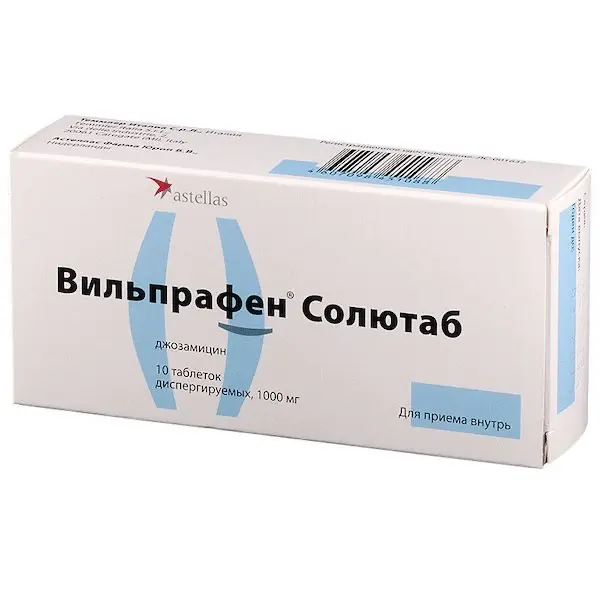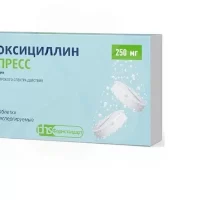Description
Vilprafen Solutab Pharmacodynamics
It is an antibacterial drug of macrolide group. The mechanism of action is associated with disruption of protein synthesis in the microbial cell due to reversible binding to 508-subunit of ribosome. In therapeutic concentrations, as a rule, it has a bacteriostatic effect, slowing down the growth and reproduction of bacteria. Bactericidal effect is possible at high concentrations in the focus of inflammation.
Josamycin is active against Gram-positive bacteria (Staphylococcus spp. including methicillin-sensitive strains of Staphylococcus aureus), Streptococcus spp. including Streptococcus pyogenes and Streptococcus pneumoniae, Corynebacterium diphtheriae, Listeria monocytogenes, Propionibacterium acnes, Bacillus anthracis, Clostridium spp. Peptococcus spp., Peptostrep- tococcus spp.), Gram-negative bacteria (Neisseria meningitidis, Neisseria gonorrhoeae, Moraxella catarrhalis, Bordetella spp. Brucella spp., Legionella spp., Haemophilus ducreyi, Haemophilus influenzae, Helicobacter pylori, Campylobacter jejuni), Bacteroides fragilis sensitivity may be variable), Chlamydia spp, including C. trachomatis, Chlamydophila spp. including Chlamydophila pneumoniae (formerly called Chlamydia pneumoniae), Mycoplasma spp. including Mycoplasma pneumoniae, Mycoplasma hominis, Mycoplasma genitalium, Ureaplasma spp. Treponema pallidum, Borrelia burgdorferi.
As a rule, it is not active against Enterobacteriaceae, so it has little effect on the microflora of the gastrointestinal tract. In some cases, it remains active with resistance to erythromycin and other 14- and 15-member macrolides (streptococci, staphylococci). Resistance to jozamycin is less common than to 14- and 15-member macrolides.
Indications
Infectious and inflammatory diseases caused by microorganisms sensitive to the drug:
Infections of the upper respiratory tract and ENT organs:
tonsillitis, pharyngitis, paratonsillitis, laryngitis, otitis media, sinusitis, diphtheria (in addition to treatment with diphtheria anatoxin), scarlet fever (in case of hypersensitivity to penicillin).
Lower respiratory tract infections:
Acute bronchitis, exacerbation of chronic bronchitis, community-acquired pneumonia, including that caused by atypical pathogens, pertussis, psittacosis.
Infections in dentistry:
Gingivitis, pericoronitis, periodontitis, alveolitis, alveolar abscess.
Infections in ophthalmology:
Blepharitis, dacryocystitis.
Skin and soft tissue infections:
Folliculitis, furunculitis, furunculosis, abscess, anthrax, rye, acne, lymphangitis, lymphadenitis, phlegmon, panarritis, wound (including postoperative) and burn infections.
Infections of the urogenital system:
Urethritis, cervicitis, epididymitis, prostatitis caused by chlamydia and/or mycoplasmas, gonorrhea, syphilis (if hypersensitive to penicillin), venereal lymphogranuloma.
Diseases of the gastrointestinal tract associated with H.pylori
Gastric and duodenal ulcer, chronic gastritis, etc.
Contraindications
– Hypersensitivity to jozamycin and other components of the drug;
– Hypersensitivity to other macrolides;
– Severe hepatic function impairment;
– Children with body weight less than 10 kg.
Pregnancy and lactation:
Use in pregnancy and during breastfeeding is permitted after a physician’s assessment of benefit/risk. WHO Europe recommends josamycin as the drug of choice for the treatment of chlamydial infections in pregnant women.
Dosage and administration
- Recommended daily dose for adults and adolescents over 14 years of age is 1 to 2 g of giovamycin. Daily dose should be divided into 2-3 doses. If necessary, the dose may be increased to 3 g per day.
- Children at the age of 1 year have an average body weight of 10 kg.
- The daily dosage for children with body weight of at least 10 kg is prescribed at the rate of 40-50 mg/kg of body weight daily, divided into 2-3 intakes: for children with a body weight of 10-20 kg the drug is prescribed at 250-500 mg (1/4-1/2 tablet dissolved in water) 2 times a day, for children with a body weight of 20-40 kg the drug is prescribed at 500 mg-1000 mg (1/2 tablet -1 tablet dissolved in water) 2 times a day, over 40 kg – at 1000 mg (1 tablet) 2 times a day. Usually the duration of treatment is determined by the doctor, ranging from 5 to 21 days, depending on the nature and severity of the infection. According to WHO recommendations, the duration of treatment of streptococcal tonsillitis should be at least 10 days.
- In the regimens of anti-Helicobacter therapy, josamycin is prescribed in a dose of 1 g 2 times a day for 7-14 days in combination with other drugs in their standard dosages (famotidine 40 mg/day or ranitidine 150 mg 2 p/day + josamycin 1 g 2 p/day + metronidazole 500 mg 2 p/day; omeprazole 20 mg (or lansoprazole 30 mg, or pantoprazole 40 mg, or esomeprazole 20 mg, or rabeprazole 20 mg) 2 p/day + amoxicillin 1 g 2 p/day + josamycin 1 g 2 p/day; omeprazole 20 mg (or lansoprazole 30 mg or pantoprazole 40 mg or esomeprazole 20 mg or rabeprazole 20 mg) 2 p/day + amoxicillin 1 g 2 p/day + jozamycin 1 g 2 p/day + bismuth tricali dicitrate 240 mg2 p/day: famotidine 40 mg/day + furazolidone 100 mg 2 p/day + josamycin 1 g 2 p/day + bismuth tricalium dicitrate 240 mg 2 p/day).
- In case of gastric mucosal atrophy with achlorhydria confirmed by pH-metry: Amoxicillin 1 g 2 p/day + jozamycin 1 g 2 p/day + bismuth tricalium dicitrate 240 mg 2 p/day.
In case of common and globular acne it is recommended to prescribe giovamycin in a dose of 500 mg twice a day for the first 2-4 weeks, then 500 mg of giovamycin once a day as a maintenance treatment for 8 weeks. - Dispersible tablets Vilprafen® Solutab® may be taken in different ways: the tablet may be swallowed whole with water or dissolved in water before intake. Tablets should be dissolved in at least 20 ml of water. The resulting suspension should be thoroughly mixed before taking.





